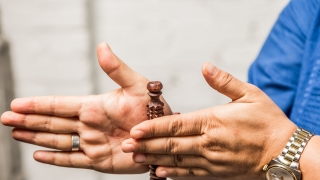
Welcome the Fall in 12 Ayurvedic and Yogic Ways
How to prepare your body and mind to the changing season?
The wisdom of Ayurveda and Yoga for the Fall season has a lot to offer.

![]() 4 minutes
4 minutes
The goal of this blog post is to give you, the reader, a starting point for building the foundation of your understanding of chakras. So much deeper meaning can be gleaned through studying word origins. Let’s begin by getting to know the chakras merely by analyzing their names. We will leave discussion such as what the chakras represent, how we work on them, and which text they connect to for another time.
The word chakra is constructed of two parts, cha and kra. Cha comes from chalana, meaning “to move.” The second half of the word, kra, is from karoti, which means “to cause.” The combination of the words, cha-kra, means “that which causes movement,” “that which causes animation,” or “that which causes any form of movement, transformation, or propulsion/moving forward.”
The meanings of the chakras vary with the different texts that we study. Based on this, the quality, quantity, and the association of the chakras can change. The basic meaning, however, remains the same, “that which causes movement and allows the subtle energy to transform into gross energy/corporeal energy” or “that which allows the redirection of the corporeal/gross physical energy, transforming it to a laser beam and converting it to subtle energy and transforming subtle energy into causal energy.”
So, to sum up, the simplest meaning or purpose of the word chakra is “movement toward/movement into/movement away from.” Let’s keep that in mind as we continue to decode the words that define the chakras.
We begin with the Muladhara chakra. Muladhara is comprised of two parts, mula and adhara. Mula means “source, sum total, foundation, basic, root.” The latter part, adhara means “that which holds.” Together, muladhara means “that which holds the sum total of energy; that which serves as the basic foundation.”
Try this Muladhara meditation with me.
Next, Swadhishthana is made of two parts, swa and adhishthana. Swa means “self or one’s self” and adhisthana means “abode, home, place.” The combination of words, Swadhishthana means “the residing place of the self or the residing place.” Here, self actually means “the most comfortable/innate place for the innate potent energy to reside, stay dormant, or inert.”
Third, we look at Manipuraka or Manipura, made of two parts, mani and pura or puraka. Mani means “semiprecious jewels,” pura means “palace,” and puraka means “that which completes.” Combined, the word means “a palace of jewels.” Here, it symbolizes or signifies that which is accomplished but of which we are not yet aware; that which lies dormant within us like semiprecious jewels—like a box of treasure—but that is not yet awakened.
Next, we consider Anahata, made of ana and ahata. Ahata means “the subtlest of the sounds; the subtlest of the sound that can be created by two objects.” An-ahata means “that which cannot be created and cannot be destroyed, therefore known as “unstruck sound.” It is the home of the unstruck primordial soundless sound Aum/OM.
Fifth, we have Vishuddhi, also made of two parts, vi and shuddhi. Shuddhi means “pure, perfect, purified.” Vishuddhi means “that which cannot become impure, that which is always pure, that which is innately pure.”
Next, Agnya or Ajna or Agya, means “permission” and “command.” This means “a place from where you receive or give yourself permission or you receive the grace from within yourself and the command to move forth, to move forward.”
Try this Ajna meditation with me.
The next, Sahasrara or Sahastrara. The word simply means “thousand,” therefore, at times, it is called the “thousand-petalled lotus.” Here, the word thousand may be considered as a definite number, but it could also symbolize thousands of petals. Here, the petals, or the thousands that we refer to is simply the sound vibrations or the light vibrations and the reference of thousand in terms of a definite number comes from the Sanskrit alphabet.
There are 50 alphabets in Sanskrit devanagri script and it is understood that every alphabet has at least 20 different meanings. When the entire spectrum of these meanings is consolidated into a laser beam of all these 50 alphabets, 50 times 20 equals 1000. This chakra is the main point that absorbs all the energies in all their permutations and combinations and becomes the seat of silence.
LEARN MORE ABOUT CHAKRAS
Practice with me:
Listen to this podcast:
Bringing Clarity to Chakras Like Never Before on Let's Talk Yoga Podcast. Here
STAY IN TOUCH
Start your FREE subscription to Indu Arora's newsletter to get more on Yoga and Ayurveda here
Say hello on Instagram
Subscribe to my Youtube Channel.

How to prepare your body and mind to the changing season?
The wisdom of Ayurveda and Yoga for the Fall season has a lot to offer.

What are the practices that lead to deeper states of mind, to higher states of consciousness?
These practices are the heart of Yoga and lead us to the state of Yoga itself.

Awareness of the subtle, intangible, and all-pervading is what allows a practitioner to reach deeper states of consciousness. With each moment that we strengthen our practice with concentration on the chakras, we are that much closer to the state of Yoga.